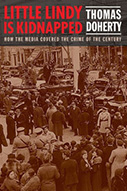Little Lindy Is Kidnapped: How The Media Covered The Crime Of The Century

Author: Thomas Doherty
Publisher: New York: Columbia University Press, 2020. 288p.
Reviewer: Mark Bernhardt | May 2021
Thomas Doherty makes a valuable contribution to the body of work on the kidnapping and murder of Charles Lindbergh’s son, and the subsequent trial of Richard Bruno Hauptmann. Though much has been written about the tragic “crime of the century,” Doherty’s book delves into the less studied role media played in covering the criminal investigation and trial, offering a comparative analysis of the three news outlets involved: newspapers, radio, and newsreel films. He gives readers a good sense of how differently they worked covering the events with the specific resources available to them.
Lindbergh’s aviation feats made him a global celebrity and, consequently, the media covered every aspect of his life. When word broke that his son had been kidnapped, reporters swarmed Hopewell, New Jersey. Likewise, Hauptmann’s trial was a media spectacle. Doherty notes that these events have been well-covered in numerous books, and explains that his purpose is to analyze the strengths and weaknesses, the differences, and the conflicts that arose in the ways media gathered information and presented it to the public. In doing so, the author produces a richly layered study that goes beyond what different news outlets said about the case, offering insight into how the industries worked and the ways in which covering these events changed them. Newspapers were the most established outlet with the biggest audience. Doherty chooses to focus on those in New York City, to discuss the ways in which reporters and publishers differed in their approaches to gathering news and presenting it from the night of the kidnapping to Hauptmann’s execution almost four years later. In the case of radio, Doherty acknowledges that only a small number of transcripts of broadcasts remain, and it is impossible to examine what they reported the way it is for newspapers. He thus primarily draws on what people in the radio industry said about covering the investigation and trial to provide an overview of how the industry worked. The significance that radio could report news at a moment’s notice, unlike newspapers, establishes what radio had to offer in that the public often got its news there first, leaving newspapers to play catchup. Compared to newspapers and radio, newsreel film producers faced many disadvantages, especially covering the investigation, because they could not always capture footage of events as they happened. Nevertheless, the public was drawn to what the films could provide — specifically recorded interviews and views of the key players. Again, Doherty looks at what those in the industry had to say about the work they did in order to get at the characteristics of its operations.
A significant shortcoming of the book is that the author does not engage with the historiography pertaining to the media coverage of the kidnapping investigation and Hauptmann trial. He states that little work has been produced in this field, but he does not discuss any of what has been written to situate his book in the literature, or even reference others’ research on the topic in his citations for readers to see what indeed has been done.
Overall, Little Lindy is Kidnapped is a well-researched and readable book that provides a good overview of how media covered and presented the kidnapping and the trial. Despite how much has been written about these historic events, there is certainly room for more work on the topic.
Thomas Doherty’s contribution offers a solid foundation for future studies.
Mark Bernhardt, Professor of History, Jackson State University


